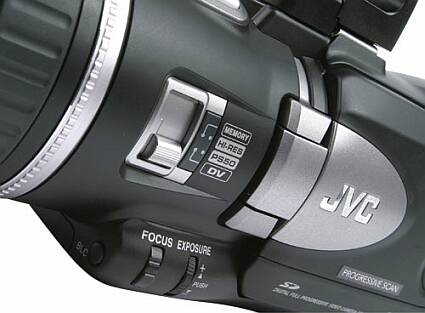Sony and JVC Take Different Tacks in the High-End Camcorder Gamut
Precision
Progressive or interlaced scanning?
The Sony DCR-VX2100 shoots in DV using interlaced scanning at 50 fields per second, known as 50i (the "i" stands for "interlaced"). Interlaced scanning is used by all mass-market DV camcorders. It uses fields (or half-images) that are interlaced to form a complete image. Scanning produces the flicker that is typical of video. The way the human retina works prevents us from detecting the half-image scan and the breaks in the image stream in television broadcasts.
The JVC GR-PD1 has three recording modes that can be changed using a switch located on the side of the device:
- interlaced 4:3 DV,
- Progressive 50p MPEG-2 that can be used as 16:9 or 4:3 (PS50),
- Progressive 25p MPEG-2 in 16:9 (HI-RES) format.
This is where the GR-PD1 is truly original. Its 25p ("p" for "progressive") mode does not display a succession of 50 half-images but a single batch of 25 complete images. This full-image scan eliminates flicker and considerably sharpens the image because it is always complete.
Incredible Precision
We filmed using the GR-PD1 in standard DV mode then in 25p mode in order to be able to appreciate the difference. We weren't disappointed. The monitor view in composite output is deceptive. A video shot in 25p with a 16:9 ratio starts to look almost like cinemascope. But you can't pan too fast because this can produce choppy images due to the progressive scanning. The definition is incredibly good, easily exceeding 600 lines, and the 16:9 format expands the field considerably. Depending on the ratio chosen, you can use an area of the sensor that can be smaller or larger - 844,000 pixels for the 16:9 at 25p, 483,000 pixels in 4:3 DV mode. The result is even better if the camcorder is attached to a YUV output component using an HD monitor or a video-projector (highly recommended to get the best out of this camcorder). Note that the GR-PD1 is the only mass-market camcorder that uses this kind of image capture. For this reason, it has higher definition than the Sony DCR-VX2100 on a screen that is restricted to the traditional composite/S-Video TV output.
| Modes & CCD Pixels | ||
|---|---|---|
| Mode | Recording Format | CCD pixels |
| HI-RES | MPEG-2 | 844,000 (progressive) |
| PS50 16:9 | MPEG-2 | 456,000 (progressive) |
| PS50 4:3 | MPEG-2 | 483,000 (progressive) |
| DV 4:3 | DV | 483,000 (progressive) |
| Still Image | JPEG | 1,120,000 |
Note: YUV encoding involves separating brightness information (black and white) from chromatic information (colors). This separation optimizes definition of the image and color rendering.
In comparison, the Sony DCR-VX2100's 16:9 mode pales into insignificance. Although there is a vertical distortion of the image to make it compatible with 16:9 monitors, it doesn't expand the horizontal field of vision. The images remain very sharp with 530-line definition.
Get Tom's Hardware's best news and in-depth reviews, straight to your inbox.
